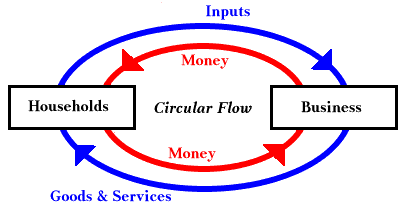The Equation of Exchange
Those who maintain that money has been an important source of economic disturbance emphasize that money enters into all transactions. When people purchase goods, they are selling money, and when merchants sell goods, they are buying money. The Circular Flow diagram illustrates that all purchases and sales involve money. The flow of goods, services, and resources moving clockwise is matched by a flow of money circulating counterclockwise.

The flow of money resembles the flow of a river. The amount of water past a point on the bank depends on the amount of water in a cross-section of the river multiplied by the velocity at which that cross section flows. In a similar way, spending in the circular flow can be found as:
(1) Amount of Money x Velocity of Circulation = Total Spending
Equation 1 is called the equation of exchange and is always true by definition. If an economy had $5.00 of money, and each dollar was spent four times a month, total monthly spending must be $20.00.1
The equation of exchange is a foundation on which the quantity theory of money is built. The quantity theory of money is a theory of the price level. It argues that inflation is caused by rapid increases in the quantity or money in circulation, and that deflation is caused by decreases or very slow increases in the quantity of money in circulation.
The equation of exchange and the quantity theory are not identical. The equation of exchange holds by definition. We get the quantity theory only by adding certain assumptions about what is cause and what is effect. The process of making assumptions began in the 16th century with the argument that the inflow of gold and silver from the Americas was causing inflation in Europe. The conquistadors who followed Columbus to the Americas sent back to Spain large amounts of gold and silver that they obtained from plundering the Aztec and Incan empires and from mining. As this metal was coined, the amount of money in circulation rose, and at the same time prices began a slow, century-long rise.
Intellectuals such as John Locke and David Hume refined the quantity theory, but the best early statement comes from an English banker, Henry Thornton, in 1802. In the early 20th century the American economist Irving Fisher popularized the equation of exchange in its mathematical form (though in his version, Fisher separated currency from checking account money, a distinction that no one makes any more). After some years of neglect, basic ideas of the quantity theory saw new life in the 1950s and 1960s under the name monetarism and re-entered mainstream economics.
To make the quantity theory work as a theory of price level, one must clearly distinguish between what happens in the long run or in equilibrium, and what can happen in the short run or in the adjustment process. The quantity theory in its original form ignores all adjustment problems, which is a legitimate way to proceed if only the long run is of interest.
Writing in 1802, Henry Thornton clearly states the central tenet of what the quantity theory suggests for equilibrium. An increase in the amount of money, he says, will neither be held idle nor greatly increase the amount of production. Thus
"There remains...no other mode of accounting for the uses to which the additional supply of it can be turned, than that of supposing it to be occupied in carrying on the sales of the same, or nearly the same, quantity of articles as before, at an advanced price the cost of goods being made to bear the same, or nearly the same, proportion to their former cost, which the total quantity of paper at the one period bears to the total quantity at the other."2
Thornton implies that total spending is made up of two parts, a price part and a quantity part. One hundred dollars of spending can buy either 25 units of output at $4.00 each, or 50 units of output at $2.00 each. In terms of the equation of exchange, this is usually written as:
(2) MV = Spending = PT
where P is a price level and T is the number of transactions.
If the amount of money in circulation doubles, the quantity theory predicts that, once in equilibrium, the price level will also double (or close to it), and that if the amount of money in circulation is cut in half, the price level will be (about) one half its former value after all adjustments have taken place. An alternative way of viewing this is to recognize that as prices go up, the value of money goes down, or since it takes more dollars to buy things, money is worth less (not worthless, however) than it used to be. The quantity theory states that an increase in the amount of money relative to goods decreases its value, and a decrease in the amount of money relative to goods will increase its value. Money is thus like any other commodity: increases in supply decrease marginal value.
Next we take a closer look at the assumptions the quantity theory is built on.
1 Note that total spending excludes barter transactions--trading one commodity for another with no money involved. If barter were included, the equation of exchange would not be true.
2 An Enquiry into the Nature and Effects of the Paper Credit of Great Britain, 1802, reprinted by August M. Kelley, 1965, p. 241.
Copyright Robert Schenk